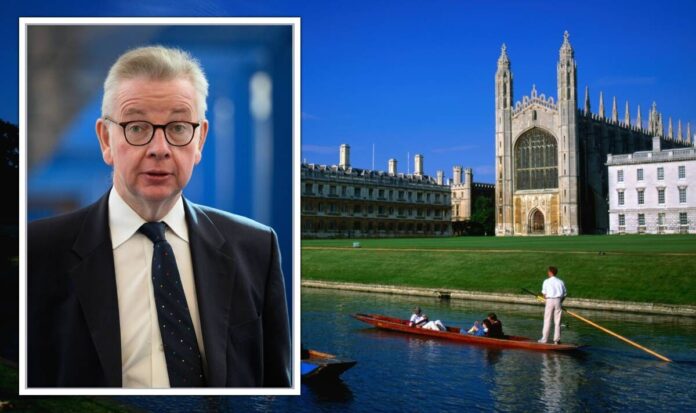Gove’s bid to build more houses in Cambridge (Image: Getty) As one of Cambridge’s 150,000 residents, I was surprised to learn via a Whitehall news leak of Michael Gove’s blueprint to turn our famously ancient town into the new urban megalopolis. The Housing Secretary is apparently not content with the already controversial (and upwardly revised) housebuilding ambitions detailed in the Cambridge local plan for targets of 50,000-plus new homes by 2040. Nor with the fact that new home development in Greater Cambridge currently outpaces almost any other area in the UK and outperforms the nationwide average by three times. Mr Gove and his Whitehall officials have determined that Cambridge’s destiny is to become, according to one source, ‘the Silicon Valley of Europe’ – to which end they propose hijacking the local plan and, according to the same source, ‘putting it on steroids’. That source is not exaggerating: Gove’s expansionist vision would see the population size of our university town increase five-fold from its current 150,000 to 750,000, skyrocketing it to the UK’s third largest city. Molly and new homes already under way (Image: Chris Radburn) That is behind only London and Birmingham in population terms and dwarfing Glasgow, Liverpool and Manchester, among others. Where we live and the community that surrounds us can in so many ways determine the quality, even the duration, of our lives. It follows that nowhere should self-determination, in respect of policy choices impacting us, be stronger than decisions which directly affect our local communities. Gove and PM Rishi Sunak eulogise about a Haussmann-designed urban quarter. But growth on this scale is not so much an urban quarter as an asphalt conurbation bolted onto a population a fifth of its size and development manifestly on a transformative scale for the character, heritage and landscape of Cambridge and its surrounding spaces. Hollow words about ‘growing beautiful integrated neighbourhoods’ leave one in little doubt Gove cannot have seen for himself the myriad Legoland-style estates springing up on the outskirts of town. Reassurances that the aim is enabling ‘brownfield development rather than green belt erosion’ evaporate on first contact with reality…as one environmental group points out: ‘Cambridge is not particularly well endowed with brownfield sites.’ Rishi Sunak with Michael Gove (Image: Getty) Leaving aside the question of how proposals to turn an already comparatively wealthy city into a cash-cow for housing developers can be said to meet a ‘levelling-up’ agenda, the proposals demonstrate a stunning, perhaps wilful, ignorance of the environmental constraints and infrastructure deficits of the area. As any local would have told Gove, crippling congestion chokes each major artery into the town most days. Rush-hour journeys of no more than a few miles into a city centre devoid of regular and reliable public transport options should take 15 minutes, but routinely take over an hour. Cambridge’s heralding as a bikeable city par excellence is baffling to those of us who actually cycle here. Narrow, potholed bike lanes render much of the routes into the city centre hazardous to cyclists, especially those of us with young kids. Schools, bursting at the seams, routinely have long waiting lists. When we first moved here four years ago, we were faced with a two-plus year wait for the local primary. Six years after the first residents moved into the Cambridge new town of Northstowe, it still does not have a single shop, cafe or GP surgery. New homes already under way (Image: Chris Radburn) Even if central government mandarins manage to muster up the capability to fashion a shining citadel boasting three times as many homes, schools, transport links and amenities than have been built in the two millennia since the Romans first arrived in South Cambs in 70 AD, there is the small matter of the water supply. Such are the concerns about water scarcity, the Environment Agency is, for the first time in its history, objecting to all major planning applications in Greater Cambridge. To get off the ground, even in Westminster’s rose-tinted bubble, the proposals have had to openly allow for a watering down (pun intended) of current environmental and pollution protections – a move the Department for Environment Food and Rural Affairs is fiercely against. It is a riding roughshod over the local environment that is symbolic of a more generalised lack of regard and engagement with the community. In a letter to Gove last week, South Cambridgeshire MP Anthony Browne said if Gove’s department had spoken to local representatives ‘they would have been told categorically that development on this scale is completely and utterly impossible to deliver for many reasons, not least because we simply don’t have enough water.’ Such complete lack of consultation with either Browne or local authorities would be astonishing were it not for the fact that Westminster makes no attempt to hide its unprecedented land-grab. ‘So this Government will now start to write the next, expansive, chapter in Cambridge’s story of scientific endeavour ‘, gushes Gove. And this is precisely the point. Gove, one of four ministers responsible for key pandemic decisions, ought, more than most, to understand decisions made behind closed doors, without the input of those most affected, without consultation of those most versed and vested in the outcome, are more likely to be flawed. Judging by the near-universal fury from all sides of the community last week, there is scant chance proposals which signal a transformative and permanent scarring of essentially an entire county would pass any local decision-making test. MP Browne rightly chastised: ‘It is…very difficult to understand how the Department for Levelling Up, Housing and Communities, knowing all this, can think that drastically increasing housebuilding in our area is in any respect a wise, credible or feasible plan.’ It is a shame those in Westminster didn’t bother to ask him.
Resident’s plea to Michael Gove over huge ‘silicon valley’ expansion
Sourceexpress.co.uk
RELATED ARTICLES


